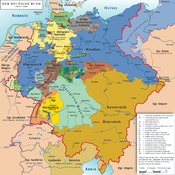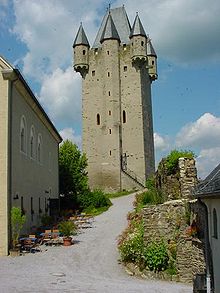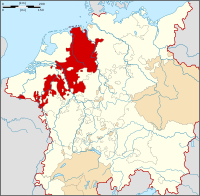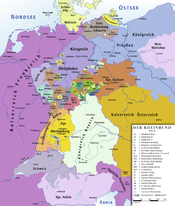- Nassau (state)
-
This article is about former state in present-day Germany. For its ruling family, including its branches in present-day Netherlands and Luxembourg, see House of Nassau. For other uses, see Nassau.
(Princely) County of Nassau
→ Principalities of Nassau
(Gefürsteter) Grafschaft Nassau
→ Fürstentümer NassauState of the Holy Roman Empire ← 
1125–1806  →
→Coat of arms
County of Nassau in 1547
Capital Nassau Government Principality Historical era Middle Ages - City founded 915 - Robert I claims title of count 1125 - Comital title acknowledged 1159 - Partitioned multiple times 1255–1806 - Remaining parts unified
to form duchy1806 Duchy of Nassau
Herzogtum Nassau (de)State of the Confederation of the Rhine
State of the German Confederation← 
←
←
1806–1866  →
→
Flag Coat of arms The duchy within the German Confederation in 1815 Capital Weilburg
Wiesbaden (after 1816)Government Principality Historical era Modern era - Duchy established 1806 - Constitution 1814 - Joined German
Confederation1815 - Annexed by Prussia 1866 - Adolphe became
Grd Duke Luxembourg1890 Nassau was a German state within the Holy Roman Empire and later in the German Confederation. Its ruling dynasty, now extinct in male line, was the House of Nassau.
Contents
Origins
Nassau, originally a county, emerged on the lower Lahn river in what is today Rhineland-Palatinate. The town of Nassau was founded in 915. Robert, son of Dudo-Henry, Count of Laurenburg, who had held Nassau as a fiefdom granted by the Bishopric of Worms, built a Nassau Castle here about 1125, calling himself "Count of Nassau". Nevertheless this title was not acknowledged by the Bishop of Worms until 1159 under the rule of Robert's son Walram.
The Nassauers held the territory between the Taunus and the Westerwald at the lower and middle Lahn. By 1128, they acquired the bailiwick of the Bishopric of Worms, which had numerous rights in the area, and thus created a link between their heritage at the lower Lahn and their possessions near Siegen. By the middle of the 12th century, this relationship was strengthened with the acquisition of parts of the Hesse-Thüringen feudal kingdom, namely the Herborner Mark, the Kalenberger Zent and the Court of Heimau (Löhnberg). Closely linked to this was the "Lordship of Westerwald", which was also in Nassau possession at this time. At the end of the 12th century, the House had also acquired the Reichshof Wiesbaden as an important base in the southwest.
After the Counts of Nassau acquired the estates of Weilburg, the sons of Count Henry II in 1255 divided Nassau for the first time. Walram II received the county of Nassau-Weilburg, while his younger brother, Otto I, held the County of Nassau-Siegen and Nassau-Dillenburg from 1328 on, the estates north of the Lahn river.The boundary line was essentially the Lahn, with Otto receiving the northern part of the county with the cities of Siegen, Dillenburg, Herborn and Haiger and Walram retaining the part south of the river with the cities of Weilburg and Idstein.
County of Nassau-Weilburg
Walram's son Adolf became King of Germany in 1292. His son Count Gerlach abdicated in 1344 and the County was divided under his sons in 1355:
- County of Nassau-Weilburg, again divided from 1442 to 1574:
- County of Nassau-Saarbrücken (Elder)
- County of Nassau-Weilburg;
- County of Nassau-Wiesbaden, again divided from 1480 to 1509:
- County of Nassau-Idstein
- County of Nassau-Wiesbaden
fell back to Nassau-Weilburg in 1605
- County of Nassau-Sonnenberg, partitioned among Nassau-Wiesbaden und Nassau-Weilburg in 1405.
In 1605, all parts of Nassau-Weilburg were again unified under Count Louis II, however after his death in 1627 his sons divided the county again:
- County of Nassau-Idstein, fell to Nassau-Ottweiler in 1721
- County of Nassau-Saarbrücken (Younger), divided again in 1640:
- County of Nassau-Saarbrücken, fell to Nassau-Ottweiler in 1723
- County of Nassau-Ottweiler, fell to Nassau-Usingen in 1728
- County of Nassau-Usingen, Principality in 1688.
- County of Nassau-Weilburg (Younger)
After Nassau-Usingen had inherited Nassau-Ottweiler with former Nassau-Idstein and Nassau-Saarbrücken, it was reunified with Nassau-Weilburg and raised to the Duchy of Nassau in 1806.
County of Nassau-Dillenburg
After the death of Count Otto I, his county was divided under his sons in 1303:
- County of Nassau-Dillenburg, fell to Nassau-Siegen in 1328
- County of Nassau-Hadamar (Elder), fell to Nassau-Dillenburg in 1394
- County of Nassau-Siegen, called Nassau-Dillenburg from 1328 on, again divided from 1341 to 1561:
- County of Nassau-Beilstein (Elder)
- County of Nassau-Dillenburg (Elder)–1606)
In 1504 Henry III of Nassau-Dillenburg inherited the County's estates at Breda in the Duchy of Brabant, while his younger brother William became Count of Nassau-Dillenburg in 1516. After the son of Henry III, René of Châlon died in 1544, Count William's eldest son William the Silent became Prince of Orange and Lord of Breda, Stadtholder in the Low Countries from 1559 on. His younger brother John VI again reunited all Nassau-Dillenburg possessions in 1561, though the County was again divided after his death in 1606:
- County of Nassau-Hadamar (Younger), Principality in 1650, fell to Nassau-Diez in 1743
- County of Nassau-Siegen, (1607–23), again divided from 1623 to 1734:
- County of Nassau-Siegen (Protestant), Principality in 1664, extinct 1734
- County of Nassau-Siegen (Catholic), Principality, fell to Nassau-Diez in 1743
- County of Nassau-Dillenburg, fell to Nassau-Beilstein in 1620
- County of Nassau-Beilstein (Younger), called Nassau-Dillenburg (Younger) from 1620 on, Principality in 1652, fell to Nassau-Diez in 1739
- County of Nassau-Diez, fell to Joachim Murat's Grand Duchy of Berg after the dissolution of the Holy Roman Empire in 1806.
The Counts of Nassau-Diez, descendants of William Frederick were stadtholders of Friesland, Groningen and Drenthe and Princes of Orange from 1702 on. Though they lost their county in 1806, the House of Orange-Nassau — in female succession — is the royal house of the Netherlands and was the reigning house of the Grand Duchy of Luxembourg until 1890.
Duchy of Nassau
On July 17, 1806 the remaining counties of Nassau-Usingen and Nassau-Weilburg joined the Confederation of the Rhine. Under pressure from Napoleon both counties merged to the Duchy of Nassau on August 30, 1806 under joint rule of Frederick August, Prince of Nassau-Usingen, and his younger cousin Frederick William, Prince of Nassau-Weilburg. As Frederick August had no heirs he agreed that Frederick William should become sole ruler after his death. However Frederick William died from a fall on the stairs at Weilburg Castle on 9 January 1816 and it was his son William who became Duke of Nassau.
At the 1815 Congress of Vienna the Principality of Orange-Nassau was incorporated into the Duchy of Nassau and subsequently the unified duchy joined the German Confederation. Through the extinction of most lines, the Nassau-Usingen branch of the Nassau-Weilburg line under Duke William became the reigning house of Nassau until after the Austro-Prussian War in 1866 it was annexed by the Kingdom of Prussia and incorporated into the Province of Hesse-Nassau. William's son Adolphe, last Duke of Nassau, received Luxembourg after the male line of Nassau-Dillenburg became extinct in 1890.
See also
- House of Nassau
- House of Orange-Nassau
- House of Nassau-Weilburg
- House of Nassau-Siegen
- Nassau Family Pact
External links
- Nassau Collection at Wiesbaden State Library
- (German) History of Nassau-Siegen
- Map of Nassau in 1789
 Lower Rhenish–Westphalian Circle (1500–1806) of the Holy Roman Empire
Lower Rhenish–Westphalian Circle (1500–1806) of the Holy Roman EmpireEcclesiastical Prelates Secular Counts
and lordsfrom 1500Bentheim · Bronkhorst (until 1719) · Diepholz · East Frisia (until 1667) · Horne3 (until 1614) · Hoya · Lingen3 · Lippe · Manderscheid (until 1546) · Moers (until 1541) · Nassau (Diez · Hadamar · Dillenburg (until 1664)) · Oldenburg (until 1777) · Pyrmont · Ravensberg3 · Reichenstein · Rietberg · Salm-Reifferscheid · Sayn · Schaumburg · Tecklenburg · Virneburg · Wied · Winneburg and Beilstein · Zimerauff?from 1792Anholt · Blankenheim and Gerolstein · Gemen · Gimborn · Gronsfeld · Hallermund · Holzapfel · Kerpen-Lommersum · Myllendonk · Reckheim · Schleiden · Wickrath · Wittemstatus
uncertainCities 1 from 1792. 2 until 1792. 3 without Reichstag seat. ? status uncertain.  States of the Confederation of the Rhine (1806–13)
States of the Confederation of the Rhine (1806–13)Rank elevated
by NapoleonKingdomsGrand DuchiesStates created KingdomsGrand DuchiesPrincipalitiesPre-existing
statesDuchiesAnhalt (Bernburg · Dessau · Köthen) · Arenberg · Mecklenburg (Schwerin · Strelitz) · Nassau · Oldenburg · Saxony (Coburg-Saalfeld · Gotha-Altenburg · Hildburghausen · Meiningen · Weimar3 · Eisenach3 · Weimar-Eisenach4)PrincipalitiesHohenzollern (Hechingen · Sigmaringen) · Isenburg-Birstein · Liechtenstein · Lippe-Detmold · Reuss (Ebersdorf · Greiz · Lobenstein · Schleiz) · Salm5 · Schaumburg-Lippe · Schwarzburg (Rudolstadt · Sondershausen) · Waldeck1 from 1810. 2 until 1810. 3 until 1809. 4 from 1809. 5 until 1811.  States of the German Confederation (1815–66)
States of the German Confederation (1815–66)Empires 
Kingdoms Electorates Grand Duchies Duchies Anhalt (Bernburg2 · Dessau2 · Köthen3) · Brunswick · Holstein · Limburg4 · Nassau · Saxe-Lauenburg · Saxony (Altenburg5 · Coburg-Saalfeld6 · Coburg-Gotha5 · Gotha-Altenburg6 · Hildburghausen6 · Meiningen)Principalities Hesse-Homburg · Hohenzollern (Hechingen7 · Sigmaringen7) · Liechtenstein · Lippe · Reuss (Elder · Junior) · Schaumburg-Lippe · Schwarzburg (Rudolstadt · Sondershausen) · Waldeck and PyrmontCity-states Other territories
outside of the
confederacyColonial possessions · Personal unions of Habsburg (Bukovina · Croatia · Galicia and Lodomeria · Hungary · Lombardy–Venetia · Serbian Voivodeship and Banat8 · Slavonia9 · Transylvania) · Personal union of Hanover (Great Britain and Ireland10) · Personal unions of Hohenzollern (East Prussia11 · Neuchâtel12 · Posen, Gr. Duchy13 · Posen, Prov.14 · Prussia, Prov.15 · West Prussia11) · Occupied: Schleswig161 w/o areas listed under other territories. 2 Merged with Anhalt from 1863. 3 until 1847. 4 from 1839. 5 from 1826. 6 until 1826. 7 until 1850. 8 1849–60. 9 as of 1849. 10 until 1837. 11 until 1829. 12 until 1848/57. 13 until 1848. 14 as of 1848. 15 as of 1829. 16 as of 1864. Categories:- Former principalities
- Former polities in the Netherlands
- States of the Holy Roman Empire
- States and territories established in 1125
- States and territories disestablished in 1806
- Former countries in Europe
- Former vassal states
- States and territories established in 1806
- States and territories disestablished in 1866
- States of the Confederation of the Rhine
- States of the German Confederation
- History of Hesse
- History of Luxembourg
- History of Rhineland-Palatinate
- Dukes of Nassau
- House of Nassau
- County of Nassau-Weilburg, again divided from 1442 to 1574:
Wikimedia Foundation. 2010.






